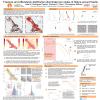Poster #104, Tectonic Geodesy
Surface deformation nearby the Ridgecrest earthquakes: Frictional slip or compliant fault?
The poster PDF is private. For more information, please contact the author(s).
Poster Presentation
2020 SCEC Annual Meeting, Poster #104, SCEC Contribution #10563
rom the earthquake sequence, with most antithetic motions associated with compliant fault deformation, where most prograde fractures resulting from shallow frictional slip. We explain these observations with a model where the crust for the entire region is critically stressed prior to large earthquakes, thus forward frictional slip is relatively easy to trigger, while the amount of stress needed for these faults to achieve critical stress status acts as a buffer that resists backward frictional slip. A major implication of these findings is that much of the prograde tectonic strain is accommodated by inelastic deformation on many pre-existing faults.
SHOW MORE
SHOW MORE


























